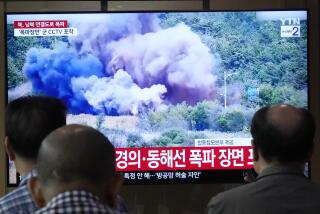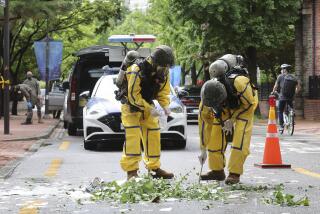Sinking of ship provides welcome distraction for North Korea
Reporting from Seoul and Beijing — Whether or not Kim Jong Il personally ordered the torpedo attack that sank a South Korean warship, the ensuing atmosphere of crisis has given the ailing dictator an opportunity to distract a population that might otherwise be complaining that they’re eating weeds instead of rice.
The furor over the March 26 sinking of the Cheonan, in which 46 sailors were killed, has given Kim an opening to stage mass rallies and conduct air defense drills in a “wag the dog” strategy.
“This will distract people from their troubles,” said Cho Myong-chol, a Pyongyang-born economist and son of a former North Korean minister. Cho, who now lives in Seoul, doesn’t believe that Kim was intimately involved in the attack.
“It is more likely that a local naval commander did it, but there could be some short-term benefit,” Cho said. “In the long run, of course, it will only make their problems worse.”
In an assessment released last week based on intelligence reports, the Washington-based International Strategic Studies Assn. concluded, “Kim Jong Il was so far winning the Cheonan incident he had instigated.”
The big loser has been South Korea’s conservative ruling party, which was trounced in local elections Thursday. The Grand National Party had hoped that outrage over the Cheonan would boost its popularity; instead the electorate appeared to be more concerned that President Lee Myung-bak was exploiting the incident with his hard-line stand toward North Korea. Results of an investigation of the sinking were not released until May 20, two weeks before the election.
Kang Won-taek, a professor of political science at Soongsil University, said people “thought the government was going back to the old days of using fear for authoritarianism and not democracy.”
South Korea’s government formally asked the U.N. Security Council on Friday to take action against North Korea. Park In-kook, the South Korean ambassador to the United Nations, said in a letter that the sinking of the warship represented a threat to peace and security on the Korean peninsula.
U.S. Defense Secretary Robert M. Gates said Saturday that planned military exercises with South Korea may be delayed until after the U.N. responds.
In Seoul, demonstrations against North Korea have drawn sparse crowds of mostly elderly war veterans, while in Pyongyang, the regime mobilized 100,000 people last weekend to demonstrate against what the official Korean Central News Agency denounced as a “smear campaign escalated by the South Korean puppet warmongers in collusion with the U.S.”
“War may break out any moment,” Choe Yong Rim, chief secretary of the Pyongyang City Committee of the Workers’ Party of Korea, was quoted as saying at the rally.
The hysteria is calculated. Pyongyang keeps vivid the memories of the 1950-53 Korean War to justify the hardships endured by the people. The famine of the mid-1990s, in which as many as 2 million people died, is known in North Korea as the “arduous march.” People were told that the scarcities were caused by a U.S. blockade and the need to devote food to the military.
At the moment, there are plenty of troubles from which to divert attention. A bungled currency reform late last year all but wiped out North Korea’s markets, making food scarcer than at any time since the 1990s.
Kim’s poor health is too obvious to be denied. The 68-year-old leader walks haltingly, with one arm partially paralyzed as the result of a stroke in 2008. The twentysomething youngest son he has tapped as his successor has yet to establish himself.
“The dynamics of the succession, the economy, all created enough turmoil in Pyongyang of the kind that Kim Jong Il would need to create a crisis or provocation in order to rally the troops under the banner of ‘us versus them,’ ” said Yossef Bodansky, a military analyst in Washington who wrote the report for the International Strategic Studies Assn.
He said that months before the sinking of the South Korean ship people in intelligence circles were saying “something nasty is going happen, but they thought it would be something related to their nuclear program, not a naval incident.”
The more immediate motivation was probably revenge. The Cheonan, a corvette, or a small warship, went down in contested waters of the Yellow Sea where two small islands less than 10 miles off the coast of the North Korean mainland are under South Korean control.
There have been frequent naval clashes in those waters. On Nov. 10, a North Korean boat is reported to have returned home “wrapped in flames.” South Korean intelligence believes 10 North Korean sailors died.
In Seoul, some analysts suggest that the Cheonan operation was directed not by Kim, but Kim Jong Un, his son and heir apparent.
“Kim Jong Un needed to establish his ability as a general very quickly by showing some sort of victory,” said Chu Sung-ha, a North Korean defector and journalist.
Andrei Lankov, one of the most respected North Korea analysts, believes that the scale of the torpedo attack does not seem characteristic of Kim Jong Il, and is more likely to be the doing of North Korean admirals seeking revenge or a hot-headed young man such as Kim Jong Eun.
“In the past, the political leadership as personified by Kim Il Sung [North Korea’s founder] or Kim Jong Il would have put a stop to such an operation,” said Lankov. “It confirms something I’ve thought was happening for a while: The quality of the decision making in Pyongyang is going down dramatically.”
Ju-min Park of The Times’ Seoul Bureau contributed to this report.
More to Read
Sign up for Essential California
The most important California stories and recommendations in your inbox every morning.
You may occasionally receive promotional content from the Los Angeles Times.










